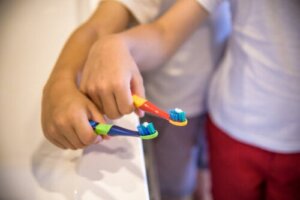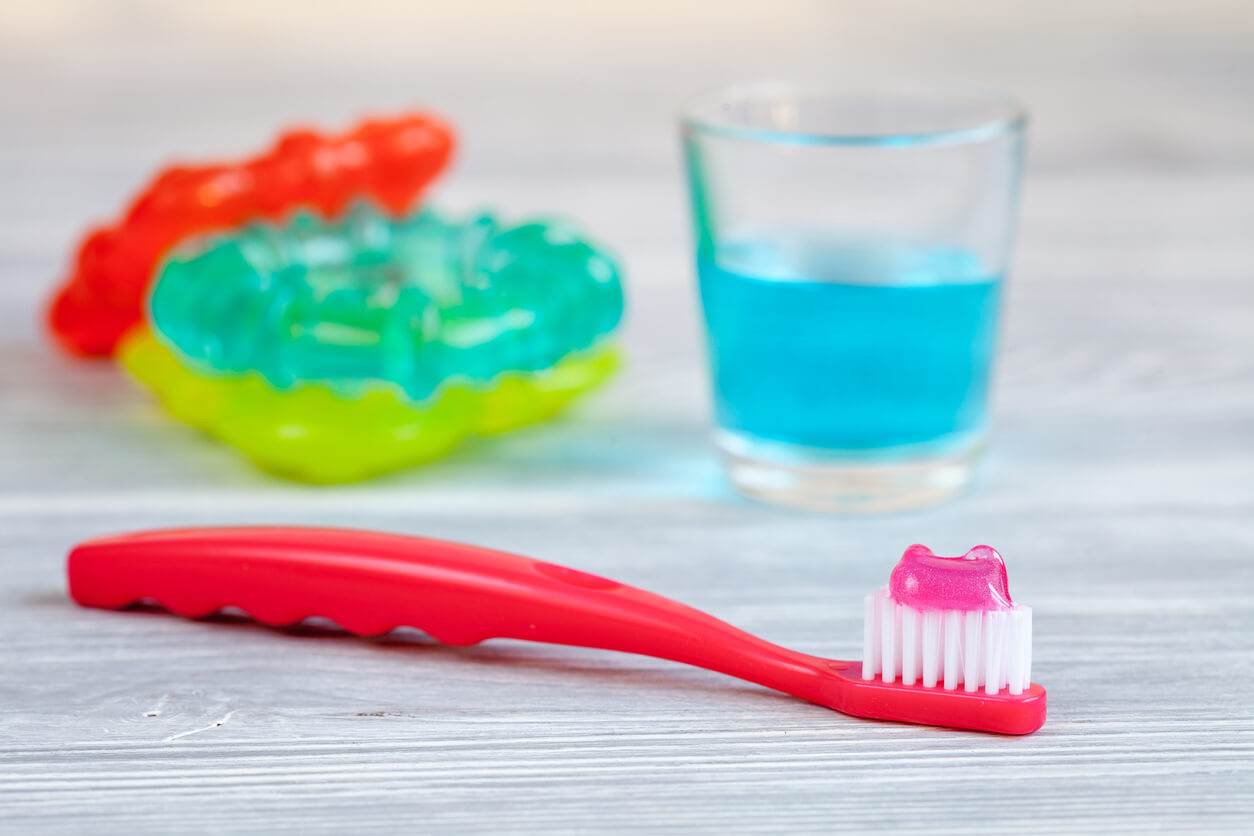How Much Toothpaste Is Recommended for Children?

When it comes to oral hygiene, many parents wonder how much toothpaste their children should use. For some, the more product they use, the better protected their teeth will be. But this isn’t the case, and in fact, using more toothpaste than recommended can be counterproductive and produce irreversible lesions in the mouth of little ones. Keep reading to find out how much toothpaste is necessary, sufficient, and safe to sanitize your children’s mouths.
The risks of too much toothpaste in children
According to a statement published by the Centers for Disease Control and Prevention (CDC), more than 40% of children between 3 and 6 years of age use too much toothpaste. This excess can be harmful to their teeth, as it increases the risk of permanent stains and discolorations.
According to the study, the information was collected through a survey of more than 5,000 parents of young children. Of these, around 40% used a toothbrush that contained more toothpaste than necessary (it occupied half or all of its surface area).
Although fluoride is a beneficial element for oral care and caries prevention, this is only true in certain doses. When ingested in excess early in life, it can lead to defects in tooth structure. This condition is known as fluorosis.
While dental elements are developing, the excessive increase of fluoride in the body can cause changes in the enamel, such as stains, discolorations, and anatomical defects in the teeth.
It should be noted that this happens when the pieces are still within the thickness of the bone and haven’t appeared in the mouth. Therefore, from the first year of a child’s life until after the age of 6, you need to be especially careful. The consequences can appear in the milk teeth and in the definitive dentition.

Recommended amount of toothpaste for children
According to the Spanish Association of Pediatrics, you should brush children’s teeth with children’s toothpaste containing 1000 parts per million (ppm) of fluoride. This should be done as soon as the first elements erupt in the mouth.
Toothpastes aren’t products that are meant to be swallowed, but in children, this is an unavoidable situation. Especially when they’re beginning to develop the ability to spit. Therefore, taking this possibility into account, specific amounts are recommended for use according to age.
From 0 to 3 years old
At this stage, calcification of the incisors and permanent molars occurs, especially between 15 and 30 months of age. That’s why it’s essential to control fluoride intake and not to overdo it.
In children under 3 years of age, the recommended amount of toothpaste is a dab no bigger than the size of a grain of rice. Caregivers are the ones who should be in charge of dental hygiene as soon as the first tooth appears in the mouth and therefore, they should be the ones to supervise compliance with this point.
Brushing should be done twice a day or according to the indications of your pediatric dentist. If possible, the child should be placed in a position that allows the toothpaste to fall out of the mouth after brushing.
Children from 3 to 6 years old
From the age of 3, the amount of toothpaste to be used is the size of a pea. They should continue with at least two brushings per day or as many times as the pediatric dentist suggests. And they should try to clean their teeth after eating sweets or soft drinks as well.
At this age, adults are still in charge of the dental hygiene of their little ones. Although children can do part of the activity to practice, caregivers must complete the process. Despite the best intentions of children at this age, they don’t yet have the motor skills necessary to perform efficient brushing.
It’s important to encourage children to spit out the toothpaste after brushing to avoid ingesting the fluoride contained in the product. This is because between 4 and 6 years of age, the premolars and second molars calcify, and controlling the excessive incorporation of this element will avoid defects in these pieces.
From 6 years of age onwards
From 6 years of age onwards a toothpaste with 1450 ppm of fluoride can be used, or the same as that used by adults. The amount of toothpaste to be placed on the toothbrush can also be increased, as children already have better control over their ability to spit.
The amount of toothpaste to be placed on the toothbrush should be one to two centimeters or a portion similar to the size of a large chickpea.
Adults should continue to supervise and accompany their children’s dental hygiene. It’s your responsibility to remind them of the need to do it, provide the toothpaste, and check that the technique is correct and that the child doesn’t swallow the toothpaste.

Fluoride is an ally that should be taken advantage of
It’s been proven that fluoride is a mineral that provides multiple benefits for dental care: It increases the resistance of the enamel, favors the mineralization of the teeth, and reduces bacterial proliferation. Therefore, it significantly reduces the risk of suffering caries.
Consequently, the use of fluoride from an early age is recommended, but its use should be done responsibly and under the advice of a pediatric dentist. Each child has their own predisposing conditions that determine the risk of suffering cavities, so their dentist will recommend the doses according to each case.
Toothpastes are a simple and convenient way to prevent cavities in children from an early age. But exceeding the recommended dosage for each age can have negative consequences, especially in the teeth that are still forming.
This’s why parents play a fundamental role in the oral health care of their children. Accompanying them at the time of dental hygiene with responsibility and without exceeding the recommended amount of toothpaste is key to ensuring good oral health.
When it comes to oral hygiene, many parents wonder how much toothpaste their children should use. For some, the more product they use, the better protected their teeth will be. But this isn’t the case, and in fact, using more toothpaste than recommended can be counterproductive and produce irreversible lesions in the mouth of little ones. Keep reading to find out how much toothpaste is necessary, sufficient, and safe to sanitize your children’s mouths.
The risks of too much toothpaste in children
According to a statement published by the Centers for Disease Control and Prevention (CDC), more than 40% of children between 3 and 6 years of age use too much toothpaste. This excess can be harmful to their teeth, as it increases the risk of permanent stains and discolorations.
According to the study, the information was collected through a survey of more than 5,000 parents of young children. Of these, around 40% used a toothbrush that contained more toothpaste than necessary (it occupied half or all of its surface area).
Although fluoride is a beneficial element for oral care and caries prevention, this is only true in certain doses. When ingested in excess early in life, it can lead to defects in tooth structure. This condition is known as fluorosis.
While dental elements are developing, the excessive increase of fluoride in the body can cause changes in the enamel, such as stains, discolorations, and anatomical defects in the teeth.
It should be noted that this happens when the pieces are still within the thickness of the bone and haven’t appeared in the mouth. Therefore, from the first year of a child’s life until after the age of 6, you need to be especially careful. The consequences can appear in the milk teeth and in the definitive dentition.

Recommended amount of toothpaste for children
According to the Spanish Association of Pediatrics, you should brush children’s teeth with children’s toothpaste containing 1000 parts per million (ppm) of fluoride. This should be done as soon as the first elements erupt in the mouth.
Toothpastes aren’t products that are meant to be swallowed, but in children, this is an unavoidable situation. Especially when they’re beginning to develop the ability to spit. Therefore, taking this possibility into account, specific amounts are recommended for use according to age.
From 0 to 3 years old
At this stage, calcification of the incisors and permanent molars occurs, especially between 15 and 30 months of age. That’s why it’s essential to control fluoride intake and not to overdo it.
In children under 3 years of age, the recommended amount of toothpaste is a dab no bigger than the size of a grain of rice. Caregivers are the ones who should be in charge of dental hygiene as soon as the first tooth appears in the mouth and therefore, they should be the ones to supervise compliance with this point.
Brushing should be done twice a day or according to the indications of your pediatric dentist. If possible, the child should be placed in a position that allows the toothpaste to fall out of the mouth after brushing.
Children from 3 to 6 years old
From the age of 3, the amount of toothpaste to be used is the size of a pea. They should continue with at least two brushings per day or as many times as the pediatric dentist suggests. And they should try to clean their teeth after eating sweets or soft drinks as well.
At this age, adults are still in charge of the dental hygiene of their little ones. Although children can do part of the activity to practice, caregivers must complete the process. Despite the best intentions of children at this age, they don’t yet have the motor skills necessary to perform efficient brushing.
It’s important to encourage children to spit out the toothpaste after brushing to avoid ingesting the fluoride contained in the product. This is because between 4 and 6 years of age, the premolars and second molars calcify, and controlling the excessive incorporation of this element will avoid defects in these pieces.
From 6 years of age onwards
From 6 years of age onwards a toothpaste with 1450 ppm of fluoride can be used, or the same as that used by adults. The amount of toothpaste to be placed on the toothbrush can also be increased, as children already have better control over their ability to spit.
The amount of toothpaste to be placed on the toothbrush should be one to two centimeters or a portion similar to the size of a large chickpea.
Adults should continue to supervise and accompany their children’s dental hygiene. It’s your responsibility to remind them of the need to do it, provide the toothpaste, and check that the technique is correct and that the child doesn’t swallow the toothpaste.

Fluoride is an ally that should be taken advantage of
It’s been proven that fluoride is a mineral that provides multiple benefits for dental care: It increases the resistance of the enamel, favors the mineralization of the teeth, and reduces bacterial proliferation. Therefore, it significantly reduces the risk of suffering caries.
Consequently, the use of fluoride from an early age is recommended, but its use should be done responsibly and under the advice of a pediatric dentist. Each child has their own predisposing conditions that determine the risk of suffering cavities, so their dentist will recommend the doses according to each case.
Toothpastes are a simple and convenient way to prevent cavities in children from an early age. But exceeding the recommended dosage for each age can have negative consequences, especially in the teeth that are still forming.
This’s why parents play a fundamental role in the oral health care of their children. Accompanying them at the time of dental hygiene with responsibility and without exceeding the recommended amount of toothpaste is key to ensuring good oral health.
All cited sources were thoroughly reviewed by our team to ensure their quality, reliability, currency, and validity. The bibliography of this article was considered reliable and of academic or scientific accuracy.
- Thornton-Evans G, Junger ML, Lin M, Wei L, Espinoza L, Beltran-Aguilar E. Use of Toothpaste and Toothbrushing Patterns Among Children and Adolescents — United States, 2013–2016. MMWR Morb Mortal Wkly Rep 2019;68:87–90.
- González Martínez, F., Carmona Arango, L., & Díaz Caballero, A. (2010). Percepción de ingesta de flúor a través del cepillado dental en niños colombianos. Revista Cubana de Estomatología, 47(3), 266-275.
- Acosta de Camargo, M. G., Palencia, L., Suárez, L., & Santaella, J. (2020). El uso de fluoruros en niños menores de 5 años. Evidencia. Revisión bibliográfica. Rev. odontopediatr. latinoam, 82-92.
- González, R. J., Carrillo, A., Santana, H. L., Urrutia, A. F., & Calva, J. C. (2020). 37. FLUOR MITOS Y VERDADES. Revista de la Academia Mexicana de Odontología Pediátrica, 32(S1), 30-31.
- Lascano, E. C. V., Zurita, C. D. R. B., & Pinos, C. I. A. (2020). El flúor en la reducción del índice de caries en niños de etapa escolar. Dilemas contemporáneos: Educación, Política y Valores.
- Guerrero-Concepción, A., & Domínguez-Guerrero, R. (2018). Fluorosis dental y su prevención en la atención primaria de salud. Revista Electrónica Dr. Zoilo E. Marinello Vidaurreta, 43(3).
- Espinel Vélez, J. E. (2022). Relación entre uso de pastas fluoradas y prevalencia de fluorosis en pacientes pediátricos (Bachelor’s thesis, Universidad de Guayaquil. Facultad Piloto de Odontología).
This text is provided for informational purposes only and does not replace consultation with a professional. If in doubt, consult your specialist.








